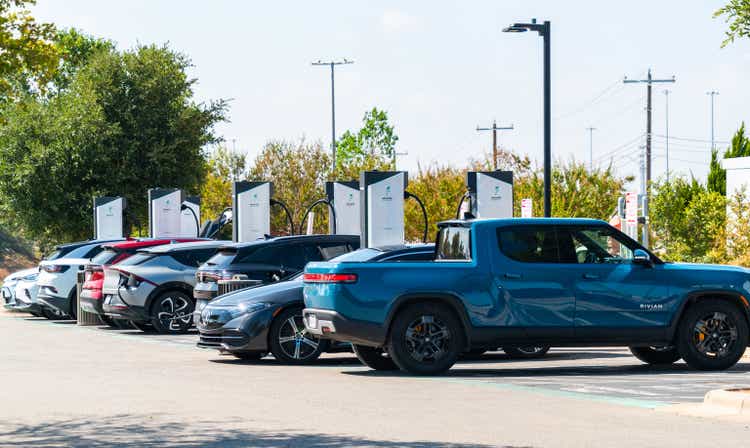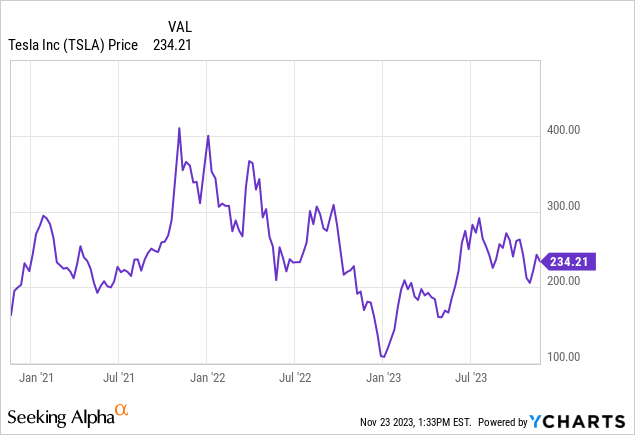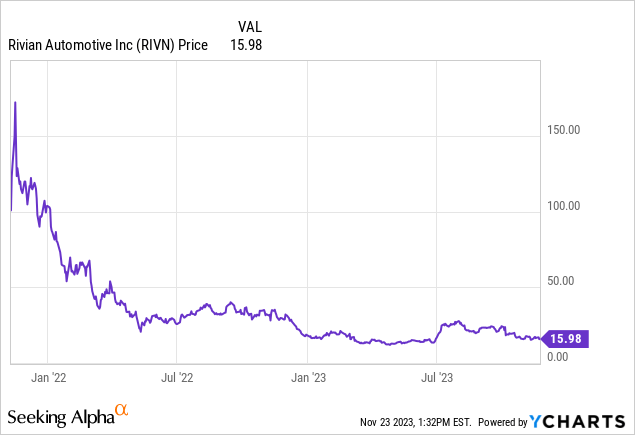Summary:
- Pioneering Paths in EV Terrain: Tesla, Inc. excels in mass market appeal with a diverse lineup, while Rivian Automotive, Inc. captivates adventure seekers with rugged, customizable vehicles.
- Market Expansion Maestros: Tesla and Rivian are not just competitors; they’re expanding the EV market, attracting distinct consumer bases, and showcasing the industry’s growth potential.
- Strategic Divergence, Collective Growth: Tesla’s broad market capture through affordability and tech contrasts with Rivian’s focus on the adventure-spirited, demonstrating the EV market’s diverse success potential.
- Technological Titans and Adventurous Innovators: Tesla’s technological edge meets Rivian’s innovative, rugged design, highlighting a synergy in the EV space where tech advancement and adventurous spirit drive industry progress.
- Beyond Rivalry, Towards Synergy: Tesla and Rivian’s differing strategies highlight the collaborative potential in the EV sector, leading to a shared goal of wider electric vehicle adoption and market evolution.
RoschetzkyIstockPhoto/iStock Editorial via Getty Images
In the electrifying race of the electric vehicle (“EV”) market, Tesla, Inc. (NASDAQ:TSLA) and Rivian Automotive, Inc. (NASDAQ:RIVN) are not just competitors; they’re trailblazers charting distinct paths in a rapidly evolving landscape.
As the long-time industry pioneer, Tesla utilizes an array of strategically targeted models to captivate wide audiences and dominate across segments – from the top-selling midrange Model 3 sedan to the futuristic Cybertruck targeting outdoor enthusiasts. 2022 sales approached 1.5 million vehicles, with particular strength shown by the affordable Model 3 and midsize SUV Model Y.
Meanwhile, Rivian has splashed onto the scene by uniquely focusing on design and customization specifically for adventure seekers valuing rugged durability as much as highway handling. While still ramping up production, Rivian’s flexible and modular skateboard platform allows extensive configuration options in its R1 pickup and SUV models tailored for off-road journeys
Rather than a typical corporate showdown, Tesla and Rivian represent a fascinating divergence of strategy within the still-nascent EV landscape. This signals an industry with ample room for growth in both mass and niche segments. They attract unique consumer bases through tailored performance, innovation in complementary technological spheres, and ultimately distinct visions for dominating their respective markets. This article analyzes how Tesla and Rivian thrive not just by competing for the same margin-rich segments, but by expanding the pie for electric vehicles overall.
While Tesla fights to retain its foothold among the wider population through broadly appealing and affordable options like the top-selling Model 3, Rivian courts passionate outdoor devotees focused on adventure-ready reconfigurability. We’ll explore the strengths, strategies, and differences that collectively widen the embrace of electric mobility.
The EV market, with Tesla and Rivian setting the pace, is far from a zero-sum game. It’s a burgeoning ecosystem where different species not only coexist but flourish. Tesla and Rivian are charting distinct paths, each targeting unique markets and customer segments. This isn’t a head-to-head battle; there’s a lot of room to explore in this market and both companies are carving out their niche.
Tesla: The Mass Market Behemoth
As the first mover and longtime market leader, Tesla continues leveraging its diverse product range catering to mass and luxury segments while forging new categories. Fueled by segments topping 400,000 and 300,000 units, respectively, in 2022, the affordable Model 3 sedan and midsized Model Y SUV serve as Tesla’s bread and butter, combining range, tech and optional autonomous driving to lure pragmatic eco-conscious consumers.
On the premium end, the Model S and Model X each push technological boundaries with triple-digit starting prices and ultrafast acceleration targeted at luxury buyers. Cybertruck preorders indicate Tesla’s ability to activate customer enthusiasm via standout industrial design even in entirely new pickup truck territory.
This multi-tiered approach allows Tesla to simultaneously retain budget-conscious middle-income families, attract high-net-worth individuals focused on exclusivity, and take risks with conceptual launches – together feeding an integrated ecosystem binding loyalists to the brand.
Rivian: The Adventurer’s Dream
As a shiny new niche player, Rivian Specifically targets outdoor enthusiasts and self-proclaimed adventurers rather than the average commuter.
The company’s January 2022 launch of its R1T truck and R1S SUV models ushered in durable yet eco-conscious vehicles equally at home off-roading remote trails as cruising suburban highways. Unique capabilities like tank turn maneuverability hint at the extreme performance Rivian intends to deliver, and Amazon (AMZN) has contracted for the delivery of 100,000 delivery trucks – a huge win for the company already.
Central to versatility lies the skateboard platform allowing for modular customization paired with a removable battery pack option – together enabling configs tailored from cargo hauling for Amazon to expanded battery range for long journeys that extend beyond the grid. Rivian realizes that catering to consumer adventure fantasies allows premium pricing power and fierce customer loyalty if executed properly.
A Synergistic Expansion of the EV Market
Tesla and Rivian are not vying for the same customers; they are expanding the EV market by creating new segments and attracting diverse consumer bases.
By offering such diverse and innovative products, Tesla and Rivian are not just coexisting in the EV market; they are enriching it. They are drawing in new customers, creating new demand, and demonstrating that the EV market is not a zero-sum game but a growing ecosystem with room for varied players.
In the realm of electric vehicles, Tesla and Rivian stand out, not just for their market segmentation but also for their distinct technological innovations. Each company has carved out its niche, leveraging unique strengths that set them apart, with Tesla focused on mass adoption and Rivian prioritizing durability.
Tesla: The Tech Titan
Tesla’s technological edge is evident in several key areas:
-
Battery Efficiency: Tesla’s advancements in battery technology, showcased during its Battery Day, have set new benchmarks in energy density and longevity. This innovation translates to a longer range and lower costs per kilowatt-hour.
-
Software Integration and Autonomous Driving: Tesla’s Full Self-Driving (FSD) software represents a leap in autonomous vehicle technology. Coupled with its sophisticated software integration, Tesla offers a seamless and futuristic driving experience.
-
Supercharger Network: Tesla’s expansive Supercharger network is a game-changer, providing widespread, convenient, and fast charging solutions, significantly reducing range anxiety for EV users.
-
Over-the-Air Updates: Tesla’s ability to push software updates over the air is akin to having a new car experience periodically. This feature ensures continuous improvement and the latest features for Tesla owners.
These interlinked areas of focus manifest in customer offerings like Full Self Driving capability and Battery Day tech unveilings stoking enthusiast flames. Together, the package drives brand loyalty among fans eagerly awaiting the next big leap. On the flip side, gaps exist around quality control and service infrastructure to enable such sophistication at scale.
Rivian: Adventure Focus through Design
Rivian, on the other hand, shines in different areas:
-
Vehicle Design and Durability: Rivian’s focus on rugged, durable designs is evident in its R1T and R1S models. These vehicles are built to withstand the rigors of off-road adventures while maintaining comfort and style.
-
Modularity and Functionality: The skateboard platform allows for remarkable modularity and customization, catering to various consumer needs, from cargo space to battery range.
-
Tank Turn Feature and Removable Battery Pack: The tank turn feature is a testament to Rivian’s innovative spirit, offering unmatched maneuverability. The removable battery pack option provides flexibility for extended adventures.
-
Gear Tunnel and Camp Kitchen: These features are a nod to Rivian’s target market – the outdoor and adventure enthusiasts. They enhance the practicality and enjoyment of outdoor expeditions.
Rivian realizes no family crossover or even Cybertruck can match purpose-built toughness for harsh environments…yet. So the company wisely courts passionate outdoor niches first through function before form. As production ramps from early stumbles, ensuring flawless execution and quality control becomes imperative to earn customer trust, especially at premium price points.
Synergy and Opportunities for Collaboration
Rather than overt competition, the EV landscape reveals opportunities for synergy between leaders like Tesla and Rivian. As Tesla navigates bringing autonomous driving and battery density improvements into mass production, it can gain from Rivian’s experience, ensuring ruggedness and real-world reliability even under extreme situations. Equally, Rivian may take cues from Tesla’s prowess in over-the-air updates, charging infrastructure logistics, and user experience polish.
The future likely holds partnering potential around nationwide charging standardization, battery modularization, fleet electrification platforms, and more. Within a massive addressable global automobile industry, growing the EV pie remains a priority one – suggesting that even rivals may collaborate toward the greater good when beneficial.
While both pivotal players in the EV market, pursue markedly different strategies and goals, reflecting their unique visions and missions. This divergence is key to understanding why the EV market is expansive rather than a zero-sum game.
Tesla: The Pursuit of Mass Adoption and Global Leadership
Tesla’s strategy is anchored in making EVs affordable and accessible, aiming to spearhead the global transition to sustainable energy. Key aspects of Tesla’s strategy include:
-
Price Reductions: Tesla has strategically reduced vehicle prices to boost demand and market share. Notably, in October 2023, Tesla slashed prices for the Model 3 and Model Y in the U.S. market, and similarly in China and Europe.
-
Production Ramp-Up: In 2023, Tesla significantly increased its production capacity, producing over 1.2 million vehicles, a 50% increase from 2022. This expansion is supported by new factories in Texas and Berlin, and upgrades in California and Shanghai.
-
Global Expansion: Tesla has ventured into new markets, including India, Indonesia, Vietnam, and Brazil, diversifying its market presence and revenue sources.
-
Product Diversification: Beyond vehicles, Tesla has expanded into sustainable energy solutions, launching products like the Cyberquad, solar roofs, Powerwalls, and the Megapack.
Rivian: Niche Differentiation to Cultivate Customer Loyalty
Rivian’s strategy, conversely, focuses on catering to the adventure and outdoor segments, aiming to build a premium brand with a loyal customer base. Rivian’s approach includes:
-
Price Premiums: Rivian maintains premium pricing to reflect its product quality and target high-end segments. In 2023, Rivian increased prices for the R1T and R1S, citing rising costs.
-
Production and Delivery Schedules: Rivian has adjusted its production and delivery timelines to ensure vehicle safety and reliability, navigating supply chain and regulatory challenges.
-
Controlled Availability and Distribution: Rivian sells its vehicles exclusively online and through its showrooms, focusing on quality control and customer satisfaction.
-
Customer Experience and Community Building: Rivian emphasizes customer engagement through initiatives like the Rivian Membership and various events and activities, fostering a strong community around its brand.
Synergy and Mutual Learning
While seemingly on divergent paths, Tesla and Rivian’s approaches remain symbiotic when considering the enormity of the addressable global automobile industry. As Tesla penetrates mass adoption, Rivian awakens passenger enthusiasm through adventure positioning less prone to direct overlap despite both being electric newcomers.
Upside exists for exchanging notes on solving challenges alike, from charging standardization to reliability at scale to navigating early manufacturing pitfalls. As the EV wave builds momentum, both companies winning bigger collectively expand the pie. Where interests align, even apparent rivals may collaborate toward advancing adoption.
Tesla and Rivian: Allies, Not Adversaries
Rather than a zero-sum landscape, Tesla and Rivian forge individual opportunities by playing to unique strengths while sharing the spirit of pioneering a new mobility era. Each attracts distinct customer psychographics spanning the gradient of EV curiosity – from budget-conscious families to premium-seeking techies to outdoor adventure addicts.
Far from cutthroat competitors, Tesla and Rivian ultimately succeed in parallel by addressing barriers still limiting mainstream adoption. As electric options permeate public perception, the rising tide can lift both, even if chasing slightly differentiated demographics. Where interests converge, allyship may weave collectively toward advancing the EV frontier.
Recommendations for Tesla and Rivian: Based on our analysis, we offer some strategic recommendations:
- For Tesla, realizing global domination means flawless execution on scaling quality manufacturing faster than rivals while continuing to captivate consumers via envelope-pushing design sprints. Minding gaps around service and reliability before accelerating off-market confidence cliffs proves prudent.
- Rivian must balance fostering adventure lust with demonstrating production discipline satisfying both demanding owners and expectant investors. Priority one remains graduating from fledgling status to established player delivering consistency quarter after quarter.
For Tesla:

-
We suggest a heightened focus on quality and reliability, addressing customer concerns and recalls. As Tesla scales up, navigating supply chain and regulatory hurdles will be crucial. Moreover, continuous innovation and differentiation are imperative to stay ahead in an increasingly competitive landscape.
As an investment:
- Tesla’s premium multiple allows little room for error, suggesting investors brace for turbulence while believing exports mirror iPhones with no adoption ceilings in sight. Potential asymmetric moves make options spreads worth consideration while monitoring consumer reception to new models.
- $234.21 is a $744.5Bn valuation for TSLA but they do have $20Bn net of debt and they are making $10.5Bn a year but, unfortunately, that’s 70x current earnings and, even projecting $13.5Bn of earnings for next year – that’s still 55x but a patient investor can look past that and assume we have a reasonable floor here so, for an options trade on TSLA – I would go with the following spread:
- Sell 5 TSLA 2026 $150 puts for $20 ($10,000)
- Buy 10 TSLA 2026 $160 calls for $113.50 ($113,500)
- Sell 10 TSLA 2026 $200 calls for $92.50 ($92,500)
That’s a net $11,000 on the $40,000 spread that’s entirely in the money to start. All TSLA has to do between now and Jan, 2026 is NOT fall $34 (14.5%) and you will make $29,000 (263%) against the cash outlay.
The worst-case scenario is TSLA dropping below $150 and you will be assigned 500 shares at net $161 ($80,500) but that’s 31% below the current price – and that’s your worst-case – so I like the trade.
Please be fully aware of the risks of trading options before placing any trades.
For Rivian:

-
We recommend prioritizing timely and budget-conscious product delivery, meeting the high expectations of investors and customers. Addressing technical and operational challenges is key as Rivian introduces complex new vehicles. Additionally, enhancing customer experience and community engagement will be vital in establishing a loyal brand following.
As an Investment:
- Rivian requires patience as early believer scrutiny gives way to post-IPO reality checks. But with room for multiple winners across the vast auto market, establishing differentiation to avoid direct competition with giants can reward those resisting dilution temptation.
- $15.98 is $15.3Bn and RIVN has $10.3Bn in cash net of debt but it’s burning $4.7Bn this year and $3.4Bn next year so you WILL be diluted before they turn a profit. RIVN has $6.5Bn in sales compared to TSLA’s $117Bn but, as we noted there is plenty of room for both to thrive in the $4.3 TRILLION Global Auto Market (69M cars sold in 2023). Still, if you are willing to own them at 37% off the current price, then there’s no harm in the following:
- Sell 20 RIVN 2026 $10 puts for $2.60 ($5,200)
- Buy 20 RIVN 2026 $10 calls for $9.60 ($19,200)
- Sell 20 RIVN 2026 $20 calls for $5.75 ($11,500)
That’s net $2,500 on the $20,000 spread so the upside potential at $20 is $17,500 (700%) and your worst-case scenario is the stock drops below $10 and you are forced to buy 2,000 shares for net $22,500 (assuming you lose the $2,500 on the spread) and that’s $11.25/share or 29.5% below the current price – I think that’s a reasonable risk/reward.
We hope this article offers valuable insights into the EV market and the distinctive roles played by Tesla and Rivian. Your thoughts and feedback are invaluable to us. We encourage you to join the conversation on the future of EVs and share your perspectives.
Analyst’s Disclosure: I/we have no stock, option or similar derivative position in any of the companies mentioned, and no plans to initiate any such positions within the next 72 hours. I wrote this article myself, and it expresses my own opinions. I am not receiving compensation for it (other than from Seeking Alpha). I have no business relationship with any company whose stock is mentioned in this article.
Seeking Alpha’s Disclosure: Past performance is no guarantee of future results. No recommendation or advice is being given as to whether any investment is suitable for a particular investor. Any views or opinions expressed above may not reflect those of Seeking Alpha as a whole. Seeking Alpha is not a licensed securities dealer, broker or US investment adviser or investment bank. Our analysts are third party authors that include both professional investors and individual investors who may not be licensed or certified by any institute or regulatory body.
